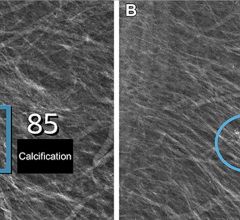
Hologic, Inc. announced the publication of the final results of a large-scale prospective study comparing breast cancer screening using Hologic’s 2D mammography plus tomosynthesis (Breast Tomosynthesis) with conventional 2D mammography published online in advance of print by The Lancet Oncology.
The study, “Integration of 3D digital mammography with tomosynthesis for population breast-cancer screening (STORM): a prospective comparison study,”[i] was led by a team of Italian and Australian researchers, represented by Associate Professor Nehmat Houssami, at the University of Sydney’s School of Public Health in Australia. The study investigated whether integrated 2D mammography with tomosynthesis was more effective at detecting cancers and reducing false positives than 2D screening alone. The analysis was based on the exams of 7,292 women with an average age of 58 who were screened at two sites in Italy.
The use of Hologic's Breast Tomosynthesis technology significantly increased cancer detection rates and simultaneously reduced false positives. Significant findings include:
- Breast Tomosynthesis identified 8.1 cancers per 1,000 screens, compared with 2D mammography alone at 5.3 per 1,000 screens, an increase in the number of cancers detected by over 50%.
- Breast Tomosynthesis resulted in a simultaneous 17% recall rate reduction.
“It is very encouraging to see this new, additional confirmation of the compelling benefits of 3D mammography,” says Edward Lipsit, M.D., president of Washington Radiology Associates, the world’s largest provider of 3D mammography. “We have used 3D mammography as a screening tool for breast cancer since August 2011 and we see the positive impact of this technology on a daily basis. Not only are we finding cancers earlier, when they are easiest to treat, we’re also eliminating much of the stress and expense associated with false positive recalls. My colleagues and I firmly believe the addition of 3D mammography to a screening exam could become the acknowledged standard of care. The clinical data that continues to emerge, including the latest study from Italy, provides strong, powerful support for this position.”
“The Italian Screening Tomosynthesis or Mammography (STORM) data underscores the clinical benefits of integrated 2D and tomosynthesis breast screening,” said Peter Soltani, Hologic senior vice president and general manager, breast health. “The statistically significant increase in cancer detection and reduction in false positives reinforces the results of previously published papers such as the Oslo tomosynthesis screening trial. As more clinical studies are published, the importance of including Hologic’s Breast Tomosynthesis technology in screening examinations will become more widely recognized and accepted by physicians and patients. Early detection of breast cancer greatly influences a woman’s chances for successful treatment and the ability to decrease the number of unnecessary recalls helps reduce patient anxiety. We believe our tomosynthesis technology sets the standard of care in breast cancer screening and diagnosis.”
Hologic’s Breast Tomosynthesis technology has been approved for use in countries recognizing the CE mark since 2008. It was approved for use in the U.S. for breast cancer screening and diagnosis in February, 2011. Hologic systems are now in use in 48 states in the U.S. and over 50 countries.
For more information: www.BreastTomo.com
[1] Ciatto S, Houssami N, Bernardi D, Caumo F, Pellegrini M, Brunelli S, Tuttobene P, Bricolo P, Fanto C, Valentini M, Montemezzi S, Macaskill P. Integration of 3D digital mammography with tomosynthesis for population breast-cancer screening (STORM): a prospective comparison study. The Lancet Oncology. Published online in advance of print, April 25, 2013.
[i] Ciatto S, Houssami N, Bernardi D, Caumo F, Pellegrini M, Brunelli S, Tuttobene P, Bricolo P, Fanto C, Valentini M, Montemezzi S, Macaskill P. Integration of 3D digital mammography with tomosynthesis for population breast-cancer screening (STORM): a prospective comparison study. The Lancet Oncology. Published online in advance of print, April 25, 2013.


 July 29, 2024
July 29, 2024 








